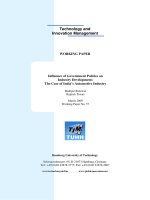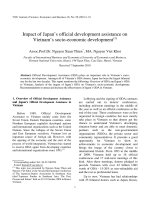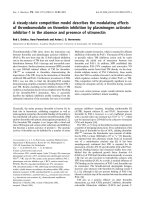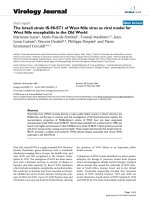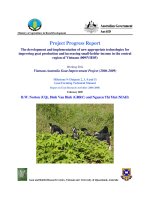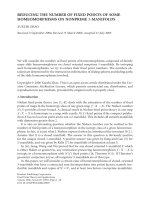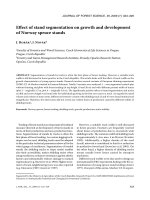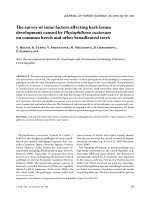Results of implementation of some policies on socio economic development for Khmer ethnic people in the Southwest region
Bạn đang xem bản rút gọn của tài liệu. Xem và tải ngay bản đầy đủ của tài liệu tại đây (1003.72 KB, 6 trang )
KINH NGHIỆM THỰC TIỄN
RESULTS OF IMPLEMENTATION OF SOME POLICIES ON
SOCIO-ECONOMIC DEVELOPMENT FOR KHMER ETHNIC PEOPLE
IN THE SOUTHWEST REGION
Nguyen Duy Dung
Vietnam Academy for Ethnic Minorities
Email:
Received: 6/10/2019
Reviewed: 14/10/2019
Revised: 23/10/2019
Accepted: 9/11/2019
Released: 20/11/2019
DOI:
I
n the past years, our Party and State have always paid
special attention and issued many important guidelines
and policies on socio-economic development for Khmer ethnic
people, including Directive No.68/CT-TW dated April 18th, 1991
of the Party Central Committee (Session VI) on working in the
Khmer ethnic minority area, Directive No.19-CT/ TW of the
Secretariat, dated January 10th, 2018 on strengthening work in
the Khmer ethnic minority region in the new situation. Thanks
to the implementation of many guidelines and policies of the
Party and the State, the lives of ethnic minorities in general and
the Khmer ethnic people in particular have been increasingly
improved, the intellectual level of people has been raised, the
rate of poor households decreases year by year. In addition, the
work of training cadres and developing party members in the
ethnic minority areas has been paid more and more attention.
Từ khóa: Socio-economic development policies; Khmer
ethnic people; The Southwest region.
1. Introduction
The Southwest region consists of 13 provinces
and cities with a natural area of nearly 40,000
km2, bordering on Cambodia with over 340 km,
with a population of provinces in the region to be
17,330,900 people, of which the Kinh people are
about 16,036 .217 people (accounting for 91.91%),
the Khmer ethnic people more than 1,260,640
people (accounting for 7.22%) (Do, 2019), the
Khmer ethnic people live in 9 provinces and cities
including Tra Vinh, Vinh Long, Can Tho, Soc
Trang, Bac Lieu, Ca Mau, Hau Giang, An Giang
and Kien Giang… This is a region with potentials
and advantages for economic development, ranking
first in the country in producing and producing
food, aquatic products and fruits. At the same
time, this is also an area of strategic importance in
politics, foreign affairs and national security.
After more than 30 years of implementing the
country renewal line (1986 up to now), especially
28 years of implementing the Directive No.68/
CT-TW dated April 18th, 1991 of the Party
Central Committee (Session VI) on working in
the Khmer ethnic people area, Directive No.19/
CT-TW of the Secretariat, dated January 10th,
2018 on strengthening work in the Khmer ethnic
minority region in the new situation, the lives of
Khmer people gradually improved, the intellectual
level of people has been raised, the rate of poor
households decreases year by year, the rural face is
Volume 8, Issue 4
gradually changed. The article evaluates the results
of implementing guidelines and policies for the
Khmer people area, from which lessons learned
from practical implementation of ethnic policies in
the Southwest region.
2. Research overview
In the past years, there have been many
researches on the Southwest region in general and
the area with large Khmer population in particular,
some typical researches including: Bui Minh Dao
(2006),“Khmer Ethnic People in the protection
and national construction of Vietnam”; Pham Thi
Phuong Hanh (2012), Southern Khmer ethnic
culture - Beauty in Vietnamese culture; Nguyen
Hoang Son (2007), “The process of implementing
the poverty reduction policies of the Party and
the State in the Khmer people community in the
Mekong Delta 1992-2002”; Nguyen Thu Thuy
(2001), “The process of implementing ethnic
policies of the Communist Party of Vietnam
towards the Khmer ethnic people in the Mekong
Delta”,... In general, the research works mention
development issues between ethnic minorities in
general and the Khmer ethnic people in particular.
However, there has not been any research works to
propose new solutions and policies to support the
Khmer ethnic people in the Southwestern region
to meet the necessary conditions for faster, more
sustainable integration and development in the
current context. This research analyzes the results
147
KINH NGHIỆM THỰC TIỄN
of implementing socio-economic development
policies and policies for the Khmer ethnic people
in the coming time, thereby contributing as a basis
and premise for policy implementation for the
Khmer ethnic people in the next stage.
3. Research method
The article uses some methods including primary
and secondary document collection methods and
statistical and statistical synthesis methods.
4. Research result
4.1. Results of some socio-economic
development policies of the Khmer ethnic people
in the Southwestern region
4.1.1. Results of implementing guidelines and
policies in the Khmer ethnic people area
After more than 30 years of implementing the
country renewal line (1986 up to now), especially 28
years of implementing the Directive No.68/CT-TW
dated April 18th, 1991 of the Party Central Committee
(Session VI) on working in the Khmer ethnic
people area and more than 1 year of implementing
Directive No.19/CT-TW of the Secretariat, dated
January 10th, 2018 on strengthening work in the
Khmer ethnic minority region in the new situation.
The central government has focused on increasing
support and investment in the Khmer ethnic people
by the Decision No.134/2004/QĐ-TTg, the Decision
No.135/2019/QĐ-TTg (the period of 2016-2020),
mainly preferential loan policies, policies on
sedentarization and settlement, policies to support
production land, residential land, houses, clean
water, daily-life electricity, policies on recruitment,
pre-university,... contribute to promoting socioeconomic in the ethnic minority region gradually
developed. In addition, farms and industrial zones
have been developing, business and service activities
are increasingly diverse, attracting a large number of
Khmer ethnic people to participate in labor, making
a significant contribution to the transfer of labor
structure in the Khmer ethnic people areas. Therein,
especially 28 years of implementing the Directive
No.68/CT-TW dated April 18th, 1991 of the Party
Central Committee (Session VI) on working in the
Khmer ethnic people area and more than 1 year
of implementing Directive No.19/CT-TW of the
Secretariat, dated January 10th, 2018 on strengthening
work in the Khmer ethnic minority region in the new
situation has achieved some important results.
Firstly, the socio-economic development
contributes to improving and raising the material
and spiritual life of the Khmer ethnic people
The implementation of guidelines and policies
of the Party and State for the Khmer ethnic people
have been actively implemented by ministries,
central agencies and localities. Therefore, the
material life of Khmer ethnic people gradually
improved significantly, the poverty rate decreased
from 29.59% in 2005 to 16.5% in 2017, the number
148
of poor Khmer ethnic households decreased on
average from 3-5%/ year (Dai Doan Ket Electronic
Newspaper, 2019)
Secondly, the educational level in the Khmer
ethnic people area has gradually been raised
In the school year of 1991-1992, the total number
of Khmer ethnic students was 116,150 (Central
Commission for Public Mobilization, 2006) or in
2009, according to survey data among 948,161
Khmer ethnic people aged 5 and over, 29.80% had
never attended school, while the whole country had
only 9, 97% (percentage of general population)
(Hanh, 2012). However, in the school year of
2014-2015, the rate of mobilizing ethnic minority
children in school age was quite high, specifically
about 50% of kindergartens, 70% of preschools,
children aged 05 years old in kindergarten over
96%, 100% primary school; junior high school to be
over 95%, high school to be about 70%, the number
of students being recruited is increasing, on average
nearly 500 students are trained every year. In the
school year of 2014-2015, there are 8,700 Khmer
ethnic students studying at 30 boarding high schools
for ethnic minorities including 6 schools meeting
national standards and 9,910 Khmer ethnic cadres
working in education, with more than 50 people
have received postgraduate training (Committee for
Ethnic Minorities, 2015c).
Thirdly, preserving and promoting the national
cultural identity is concerned to perform well
The curriculum of Khmer writing is being
taught and learned at the primary schools in the
Khmer ethnic minority area, the boarding ethnic
minority high schools and in the Khmer pagodas
are always maintained. Khmer art troupes are
interested in and created conditions by all levels.
The Ministry of Culture, Sports and Tourism has
recognized the art forms such as Cham Rieng Cha
Pay, Parachute theater art of the Khmer ethnic
people in Soc Trang province and Ok Om Bok
festival of Khmer ethnic people in Tra Vinh province
to be a national intangible culture. At the same time,
creating favorable conditions for Khmer ethnic
artists to participate in cultural, literary and artistic
activities at the ethnic chapters of the Association of
Literature and Arts, Vietnam Association of Theater
Artists and Vietnam Dance Artists Association.
Nam, Vietnam Association of Musicians, Linked
Association of Vietnamese Theater Artists in the
Mekong Delta.
Fourthly, maintaining national defense, security,
social order and safety
The localities in the Southwest region have
regularly launched a mass movement to protect the
national security in every village and have been
actively responded to participate by the Khmer
ethnic people. In particular, the localities have
promoted the role of a team of prestigious people
JOURNAL OF ETHNIC MINORITIES RESEARCH
KINH NGHIỆM THỰC TIỄN
among ethnic minorities in the spirit of the Prime
Minister’s Directive No. 06/2008/CT-TTg, dated
February 1st, 2008 about “promoting the role of
prestigious people in ethnic minorities in the cause
of national construction and defense”; Decision
No. 18/2011/QĐ-TTg, dated March 18th, 2011 of the
Prime Minister on policies for prestigious people in
ethnic minorities; and Decision No. 12/2018/QĐTTg, dated March 6th 2018 of the Prime Minister on
criteria for selection and recognition of prestigious
people and policies for prestigious people in ethnic
minority groups... Contributing significantly in
propagating and mobilizing ethnic minority people
to abide by the Party’s guidelines and policies, the
State’s laws, well fulfilling citizen obligations,
actively participating in revolutionary movements,
promoting the tradition of solidarity and mutual
assistance for development, heightening vigilance
for the revolution, preserving security and order at
the grassroots level.
Fifth, the political system of ethnic minority
areas is particularly concerned by local Party levels
The construction of grassroots political system
in the ethnic minority area has been gradually
strengthened. The contingent of party members,
cadres, civil servants and officials who are ethnic
minority people increases annually in quantity and
quality.
4.2. Result of implementing some economic
development policies for the Khmer ethnic minority
area
In the past years, our Party and State have issued
many guidelines, policies to increase investment,
supporting ethnic minorities for comprehensive
development. While the implementation of
Decision No.74/2008/QĐ-TTg, resulted in
localities disbursing 62.41% of the allocated funds,
settling land for 7,912 households in need of
residential land, 6,055 households have demand for
productive land, 26,817 households have demand
for job creation, 5,070 households have demand for
loans to buy machinery and agricultural tools and
vocational training for 19,098 laborers (including
03 workers are supported to go to work abroad)
(Local Department III & Committee for Ethnic
Minorities, n.d.) . Subsequently, the localities in the
Southwest region with a large number of Khmer
ethnic minorities implemented policies to support
residential land, productive land and create jobs
for poor ethnic minority people, difficult life in
the Mekong River delta according to Decision No.
29/2013/QĐ-TTg dated May 20th, 2013 with the
initial beneficiary needs of ethnic minorities in the
whole region as follows: 7,291 households in need
of residential land; 4,219 households have demand
for productive land; 18.609 households in need of
loans to create jobs and develop production; 11,694
workers with vocational training demand and 65
Volume 8, Issue 4
workers with labor export demand1.
In 2015, the State allocated a total budget
of VND 642.55 billions to localities to support
residential land for 3,053 households (728,711
hectares), redeeming production land for
1,042 households (102 hectares), loans for job
creation and production development were 3,591
households, 1,523 labors supported with vocational
training and 03 labor export (Committee for Ethnic
Minorities, 2015a) (by the end of June 2016, 3,446
households will be supported with residential land,
1,242 households will be able to redeem production
land) (Committee for Ethnic Minorities, 2015b).
Thus, up to now, the localities have just solved
48.42% of households with demand for residential
land and 29.49% of households with demand for
productive land. Particularly for the support for
conversion and vocational training under Scheme
No. 1956 implemented by the Ministry of Labor,
War Invalids and Social Affairs, in the whole
5-year period (2010-2015), there are 437,361
ethnic minority people to be supported to receive
training occupation, accounting for 20.1% of the
total rural labor force, of which the Southwest
region has only 12.9% of the trained laborers under
the Scheme (The Ministry of Labor, n.d.). About
labor structure and economic structure, the labor
force in agriculture in the Southwest region is very
high but the rate of trained workers is still very low,
specifically: “In 2010, it was 49.50%, by 2014,
46% of the labor force in agriculture, however, the
number of trained laborers were 2.40% in 2010 and
3.60% in 2014 (Hau Giang province, 2016). Most
of the policies on vocational training and vocational
change for ethnic minorities have been focused on
linking vocational training for rural workers with
the implementation of agricultural, farmer, rural
. Source: Local Department III, Committee for Ethnic Minorities:
According to local reports, households and workers have needs to
enjoy, specifically as follows: Tra Vinh: 2,157 households (residential land), 732 households (productive land), 4,691 households (borrowing capital to create jobs), 505 laborers (vocational training) and
03 employees (labor export); Vinh Long: 31 households (residential
land), 179 households (productive land), 126 households (borrowing capital to create jobs); Can Tho: 104 households (residential
land), 09 households (productive land), 256 households (borrowing
capital to create jobs), 08 laborers (vocational training); Soc Trang:
1,561 households (residential land), 1,406 households (productive
land), 10,429 households (borrowing capital to create jobs), 7,728
laborers (vocational training) and 62 laborers (labor export); Bac
Lieu: 1,234 households (residential land), 300 households (productive land), 910 households (borrowing capital to create jobs); Ca
Mau: 985 households (residential land), 253 households (productive
land), 530 households (borrowing capital to create jobs); Hau Giang: 301 households (residential land), 525 households (productive
land), 719 households (borrowing capital to create jobs), 23 laborers
(vocational training); An Giang: 395 households (residential land),
518 households (productive land), 948 households (borrowing capital to create jobs), 1,510 laborers (vocational training) and 02 laborers (labor export); Kien Giang: 523 households (residential land),
297 households (productive land), 422 borrowing capital to create
jobs), 1,920 laborers (vocational training).
1
149
KINH NGHIỆM THỰC TIỄN
policies and new rural construction program; thanks
to the policy of supporting vocational training and
changing jobs of the Prime Minister’s Decision
No. 74/QĐ-TTg dated June 9th, 2008 on a number
of policies to support the settlement of residential
land, production land and solve jobs for poor ethnic
minorities, difficult life in the Mekong River Delta
in the period of 2008-2010; the Prime Minister’s
Decision No. 29/QĐ-TTg dated May 20th, 2013 on
a number of policies to support the settlement of
residential land and employment for poor ethnic
minorities and difficult life in the Mekong River
Delta area in the period 2013-2015; and the Prime
Minister’s Decision No. 1956/QĐ-TTg dated
November 27th, 2009 on approving the Scheme
“Vocational training for rural labor until 2020”...
the households who have no productive land,
have to work as hired laborers or have no stable
jobs, are now supported with vocational training
capital and conversion of traditional agriculture
to growing crops, breeding animals and wholesale
selling or going to work overseas ... since then
many ethnic households have strived to get out of
poverty, improving the quality of life, contributing
to economic restructuring, social security.
However, the resolution for beneficiaries of policies
according to the Prime Minister’s Decision No. 29/
QĐ-TTg has not been effective, as follows: 18,609
households needing loans to create jobs, so far
only 2,605 households (accounting for 14%) have
been implemented and “according to the report of
the Social Policy Bank through the National Fund
for employment, as of April, 2016 supported jobs
for 3,692 employees in the region” (The Ministry
of Labor, 2016); supported 1,523 /11,694 workers
(vocational training), accounting for 13%, 03/65
employees (labor export), accounting for 4.6% and
12.9% of trained workers according to Scheme
1956, “while the current rate of trained workers
in the whole region to be 49.14%” (The Southwest
Steering Committee, 2015)
4.2. Evaluating the results of implementation of
guidelines and policies for the Khmer people area
4.2.1. Advantage
- Policies, programs and projects on economic
development in ethnic minority areas in general
and in Khmer ethnic minority area in particular
are major undertakings of the Party and the State,
suitable to the people’s hearts, to all classes of
people and Khmer ethinc people actively responded
and agreed to support. The policies and programs
have contributed to improving and raising the
material and spiritual life of the people, creating
the trust of the people with the Party and the State,
contributing to maintaining the political security
and security order, the whole society in the area
with a large number of Khmer ethnic people.
- In the course of organizing and directing
the implementation of programs and policies, the
central ministries and branches have promptly
150
implemented and timely trained decisions, circulars
and guiding documents; organizing inspection and
supervision to the commune, hamlet, residential area
and household. From there, directing localities to
rectify deviations in time, urging the implementation
of better policies. Local authorities also quickly
consolidated and established a Steering Committee
to implement policies, decentralization and
assignment in the process of concretizing decisions,
circulars, directive documents of the Government
and ministries, Central sectors. By many popular
organizational forms, thorough propaganda has
created a really profound change in awareness
inside and outside the public to implement at the
grassroots level to ensure democracy, openly and
transparently, such as registering households to
escape from poverty, decentralizing specifically
to the commune-level People’s Committees in
approving the list of poor households, households
escaping from poverty and arising poor households,
developing plans and measures to help households
escaping from poverty, which has focused on
solutions to help sustainable poverty escape such
as supporting for vocational training, job creation,
production development support, housing support...
at the same time, all levels and branches have
regularly inspected and urged to remind that the
implementation should be good.
- The contingent of commune and hamlet
officials has been gradually improved in
management, administration and implementation of
local policies, programs and projects. The political
system has been increasingly strengthened and
consolidated, the strength of the great unity bloc of
the entire nation has become a decisive factor in all
fields. The rural face of the Khmer ethnic minority
area has changed and prospered.
- Awareness and identification of poverty
reduction work for the Khmer ethnic people is
always inseparable and inseparable from the
local socio-economic development tasks, so all
levels and sectors have closely coordinated in
the implementation of guidelines, policies and
solutions to support poor and near-poor households.
Propaganda in many ways has promoted efficiency,
the people, especially the poor who have been more
properly aware and actively participated in poverty
reduction activities.
- The implementation of policies creates a
new spirit in the spirit of the people of the Khmer
ethnic minority area, promoting the tradition of
solidarity, helping each other develop together
in the community, contributing to implementing
the real current regulations on democracy at the
grassroots level and the campaign of all people to
unite to build a cultural life.
4.2.2. Difficulty
- The mobilization of human resources to
contribute to socio-economic development
programs is still limited. The integration of other
JOURNAL OF ETHNIC MINORITIES RESEARCH
KINH NGHIỆM THỰC TIỄN
programs, projects and policies to promote socioeconomic efficiency is not high. Infrastructure and
life of the people have been improved, but they still
face many difficulties, the number of households
escaping from poverty quickly, however is not
sustainable, the rate of poor households decreases
slowly, especially for ethnic minority households.
- The propaganda, dissemination, internal
thoroughness and people are limited, especially
some Khmer ethnic households do not fully
understand the purpose and significance of the
program to invest in extremely difficult hamlets.
The mobilization of resources to contribute to
the program is limited. The integration of other
programs, projects and policies for communes
135, II area communes to promote socio-economic
efficiency to be still low. Infrastructure and life
of the people have been gradually renovated,
developed but still facing difficulties.
- A part of the Khmer ethnic people still lacks
land, capital and means of production. Poverty
reduction has not been sustainable, the situation of
falling back into poverty among the Khmer ethnic
people remain high. The situation of market price
fluctuations increased for essential goods what
directly used by people and has affected the daily
life and life of poor ethnic minority people making
their already difficult life, even more difficult again.
- Educational level, cultural enjoyment of
ethnic Khmer people in some places is not high.
The quality and effectiveness of education and
training of children of Khmer ethnic people are not
high. The contingent of the Khmer ethnic cadres
is still limited in qualification. Planning, training,
retraining cadres and building political systems at
grassroots level in Khmer ethnic minority areas have
not met the requirements setting in the international
integration context.
4.3. Learned lessons of experience
Through the achievements gained after more than
30 years of implementing the country’s renovation,
28 years of implementing Directive No. 68/CT-TW
and more than 1 year of implementing Directive
No. 19/CT-TW, learned lessons of experience from
practical implementation of ethnic policies in the
Southwest region, specifically as:
Firstly, the lesson of the deep concern of the
Party committee levels, the authorities, unions to
the ethnic affairs, the reality shows that localities
pay proper attention to the ethnic affairs in the
development process when implementing the Party
and State’s guidelines and policies are effectively
achieved in that locality.
Secondly, using appropriate ethnic minority
cadres to arrange reasonably in agencies and mass
organizations at all levels in the political system.
Thirdly, synchronously implementing guidelines
and policies of the Party and State, meeting the
requirements as well as the real needs of the ethnic
Volume 8, Issue 4
people, avoiding support, dripping and spreading
investment.
Fourthly, strengthening the work of mass
mobilization, promoting propaganda, regularly
encouraging, motivating spirit, praising positive
factors, promoting cultural, historical and traditional
values of the ethnic minorities to create consensus,
supporting from the the ethnic minorities, improving
the belief of the people for the Party and State and
the socialist regime, promoting the great unity bloc
of the whole nation.
5. Conclusion
In the process of existence and development, the
ethnic minorities in the Southwest region in general
and the Khmer ethnic people in the Southwest region
in particular are an inseparable part of the Vietnamese
ethnic community. In the renovation period,
especially in the period of accelerating the country’s
industrialization, modernization and international
economic integration, along with the whole country,
the ethnic minorities are facing new opportunities
and challenges in development. The effort to rise
up among the ethnic minorities and the Party and
State’s guidelines and policies has helped improve the
material and spiritual life of the ethnic people.
However, the rise of the ethnic people is not
equal in some localities, the rate of poor households
to be still high, the educational level to be still low.
Therefore, in the coming time, it is necessary to
promote poverty reduction, vocational training and
job creation in order to improve the living standards
of the ethnic people; raising the awareness and
national pride among the people, especially the
youth, the young intellectuals and young officials;
improving the quality of ethnic minority teaching
and learning to meet assigned tasks requirements;
strengthening training of human resources among
the ethnic minorities, proceeding to use the ethnic
minority human resources corresponding to the rate
of the population in each locality in the spirit of
Decision No. 402/QĐ-TTg dated March 14th, 2016
on Approving the Scheme on development of ethnic
minority officials, public servants and employees in
the new period.
The localities have always focused on the
effective implementation of the Ethnic Minority
Strategy in Decision No. 449/QĐ-TTg dated March
12th, 2013 and the Action Program to implement
the Ethnic Minority working strategy to 2020 in
Decision No. 2356/QĐ-TTg dated December 4th,
2013; Joint Circular No. 02/2014/TTLT-BNVUBDT dated September 11st , 2014, detailing and
guiding the implementation of policies on ethnic
minority officials, public servants and employees in
Article 11 of the Decree No. 05/2011/NĐ-CP and
especially Resolution No. 52 /NQ-CP dated June
15th, 2016 of the Government “on the development
of ethnic minorities human resources in the
period of 2016-2020, with orientation to 2030”
contributing to accelerating and firmly developing
151
KINH NGHIỆM THỰC TIỄN
the sustainable development of ethnic minority
communities in the Southwest region in general and
Refferences
Central Commission for Public Mobilization.
(2006). Summary of the implementation
organization of Directive No. 68/CT-TW of
the Party Central Committee’s Secretariat
(Session 6) on working in ethnic minority
Khmer areas. Hanoi.
Committee for Ethnic Minorities. (2015a).
Report No. 159/BC-UBDT dated December
4th. Hanoi.
Committee for Ethnic Minorities. (2015b). Report
No. 82/BC-UBDT dated June 27th. Hanoi.
Committee for Ethnic Minorities. (2015c).
Report on ethnic minority situation and
implementation of ethnic policies in the
Southwest region in 2015. Hanoi.
Dai Doan Ket Electronic Newspaper. (2019, May
3). Taking care of life for the Khmer ethnic
people.
Dao, B. M. (2006). The Khmer ethnic people in
the cause of national defense and construction
of Vietnam. Ethnic Journal, (No. 5).
Do, H. M. (2019). Features of the region,
residents and Khmer Theravada Buddhists
of the Southwest region - Issues raised today.
Journal of Ethnic Minorities Research, 8(3).
Hanh, P. T. P. (2012). Southern Khmer Culture
- Beauty in Vietnamese Culture. Hanoi:
Publishing House of National Politics of
Truth.
the Khmer ethnic minority areas in particular.
Hau Giang province. (2016). Mekong River Delta
Economic Cooperation Forum – Hau Giang
in 2016. pp.112-118. Hau Giang.
Local Department III, & Committee for
Ethnic Minorities. (n.d.). Summary of the
implementation of Decision No. 74/2008/QĐTTg.
Son, N. H. (2007). The process of implementing
the poverty reduction policy of the Party
and the State in the Khmer community in the
Mekong River Delta 1992-2002. (Doctorial
Thesis).
The Ministry of Labor, I. and S. A. (n.d.). Report
No. 2905/LĐTBXH-VPQGGN. Hanoi.
The Ministry of Labor, I. and S. A. (2016). Report
No. 2450/LĐTBXH-KHTC dated June 30th.
Hanoi.
The Party Central Committee (Session VI).
(1991). Directive No.68/CT-TW dated April
18th.
The Southwest Steering Committee. (2015).
Report No. 246-BC/BCĐTNB dated
December 28th. Hanoi.
Thuy, N. T. (2001). The process of implementing
the ethnic policies of the Communist Party
of Vietnam for the Khmer ethnic people in
the Mekong River Delta. (Doctorial thesis of
History, Ho Chi Minh National Academy of
Politics).
KẾT QUẢ THỰC HIỆN MỘT SỐ CHÍNH SÁCH PHÁT TRIỂN KINH
TẾ - XÃ HỘI ĐỐI VỚI ĐỒNG BÀO DÂN TỘC KHMER VÙNG TÂY
NAM BỘ
Nguyễn Duy Dũng
Học viện Dân tộc
Email:
Ngày nhận bài: 6/10/2019
Ngày phản biện: 14/10/2019
Ngày tác giả sửa: 23/10/2019
Ngày duyệt đăng: 9/11/2019
Ngày phát hành: 20/11/2019
DOI:
152
Tóm tắt: Trong những năm qua, Đảng và Nhà nước ta luôn dành
sự quan tâm đặc biệt và đã ban hành nhiều chủ trương, chính sách
quan trọng về phát triển kinh tế-xã hội đối với đồng bào Khmer, trong
đó có Chỉ thị 68/CT-TW ngày 18/04/1991 của Ban Chấp hành Trung
ương Đảng (khóa VI) về công tác ở vùng đồng bào Khmer, Chỉ thị số
19-CT/TW ngày 10/01/2018 về tăng cường công tác ở vùng đồng bào
dân tộc Khmer trong tình hình mới. Nhờ thực hiện nhiều chủ trương,
chính sách của Đảng và Nhà nước, đời sống đồng bào dân tộc thiểu
số (DTTS) nói chung và đồng bào dân tộc Khmer nói riêng ngày càng
được cải thiện, trình độ dân trí được nâng cao, tỷ lệ hộ nghèo giảm
theo từng năm. Bên cạnh đó, công tác đào tạo đội ngũ cán bộ và phát
triển đảng viên trong vùng đồng bào các dân tộc ngày càng được quan
tâm, chú trọng.
Từ khóa: Chính sách phát triển kinh tế - xã hội; Đồng bào dân tộc
Khmer; Vùng Tây Nam Bộ.
JOURNAL OF ETHNIC MINORITIES RESEARCH
